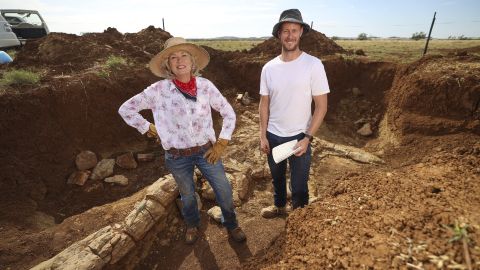CNN
–
Researchers have hailed the discovery of a giant 100-million-year-old marine reptile skeleton in Australia as a breakthrough that could provide vital clues about prehistoric life.
Three amateur fossil hunters found the remains of a juvenile six-meter (19-foot) plesiosaurus, also known as Elasmosaurus, at a cattle station in remote western Queensland in August.
Espen Knutsen, senior curator of paleontology at the Queensland Museum, likened the find to the discovery of the Rosetta Stone – an ancient Egyptian granite block rediscovered in 1799 that helped experts decipher hieroglyphs.
“We have never found a body and a head together and this could hold the key to future research in this area,” Knutsen said in a statement Wednesday confirming the discovery, adding that it could give paleontologists deeper insight into origins, evolution and ecology. from the Cretaceous period in the region.
“Because these plesiosaurs were two-thirds a neck, the head was often separated from the body after death, making it very difficult to find a fossil that preserved both together,” he said.
The discovery was made by amateur paleontologists known as the “Rock Chicks” – Cassandra Prince, her sister Cynthia, and colleague Sally, who only uses her first name.

Elasmosaurs, which grew to between 8 and 10 meters long, lived in the Eromanga Sea, which covered large parts of inland Australia with water 50 meters deep about 150 million years ago.
Knutsen told CNN that when an Elasmosaurus died, its decaying body would swell with a gas that made it rise to the surface of the water, and the head would often break off when predators excavated the corpse — making finds of the whole body rare.
He added that since the latest discovery was a small specimen, it would shed light on how the body shape of elasmosaurus changed from youth to adulthood.
“We’re going to take a look at the chemistry of its teeth and that can tell us something about its habitat in terms of habitat as well, whether it’s been migrating for its entire life, whether it’s a survival type of habitat, and also in its diet.”
Ancient marine reptiles such as plesiosaurs and ichthyosaurs are not classified as dinosaurs even though they lived around the same time. Plesiosaurs evolved from ancestors that lived on land and therefore had no gills and had to emerge occasionally for air. It is still unknown how long they can stay under water.

It is the latest major prehistoric discovery made in Australia in recent years.
In June last year, Scientists confirmed The 2007 discovery of a fossilized skeleton in Queensland was the largest dinosaur in the country. Nicknamed “Cooper,” the dinosaur was about two stories tall and was as long as a basketball court.
Two months later, scientists discovered that there was a kind of flying dragon that rose over Australia 105 million years ago. Researchers have described the pterosaur as a “terrifying beast” that preyed on young dinosaurs.

“Beer aficionado. Gamer. Alcohol fanatic. Evil food trailblazer. Avid bacon maven.”
